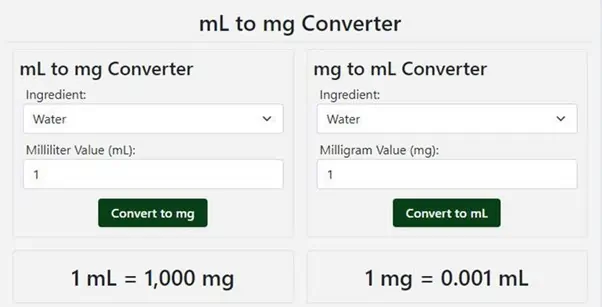Accurate measurements are paramount in various fields, from scientific research to everyday activities. Whether you’re a scientist conducting experiments, a pharmacist preparing medications, or a home cook following a recipe, understanding units of measurement is essential. One common conversion that often arises is converting millilitres (mL) to milligrams (mg) by this website. To master this conversion, it is crucial to grasp the relationship between mass and volume. In this article, we will delve into the basics of mass and volume and provide a step-by-step guide on converting mL to mg.
Mass and volume are fundamental properties of matter, playing significant roles in our understanding of the physical world. Mass refers to the quantity of matter in an object, while volume measures the space occupied by that object or substance. Although distinct, mass and volume are interrelated. When converting between mL and mg, the density of the substance being measured becomes a key factor.
Density, defined as the mass per unit volume, represents the concentration of matter in a substance. It is commonly expressed in grams per millilitre (g/mL) or kilograms per cubic metre (kg/m³). Each material possesses a unique density due to the arrangement of its atoms or molecules. For example, water has a density of approximately 1 g/mL, while olive oil has a density of around 0.92 g/mL.
To convert mL to mg, it is essential to consider the density of the substance in question. Let’s use water as an example and outline the step-by-step process of converting mL to mg:
Step 1: Identify the given volume in millilitres (mL).
Suppose we have a quantity of 50 mL of water that we want to convert to milligrams (mg).
Step 2: Determine the density of the substance.
In the case of water, the density is 1 g/mL or 1000 mg/mL. This means that every milliliter of water weighs 1000 milligrams.
Step 3: Set up the conversion factor.
Knowing that 1 mL of water equals 1000 mg, we can establish the following conversion factor:
1 mL = 1000 mg.
Step 4: Cancel out the units.
To convert mL to mg, we apply the conversion factor to cancel out the milliliter unit, resulting in milligrams. By multiplying the given volume (50 mL) by the conversion factor, we obtain the answer:
50 mL x (1000 mg/1 mL) = 50,000 mg.
Therefore, 50 mL of water is equivalent to 50,000 mg.
It is important to note that this conversion method assumes the substance has a density of 1 g/mL. If the substance has a different density, the conversion factor will vary accordingly. To ensure accurate conversions from mL to mg, consulting reliable sources or reference materials for the specific density of the substance in question is crucial.
Furthermore, it is worth mentioning that converting between milliliters and milligrams is not a universal conversion. It applies specifically to conversions between volume and mass for substances with known densities. For other conversions involving different units or substances, different conversion factors and formulas may be necessary.
Conclusion:
In conclusion, converting mL to mg requires an understanding of the basic concepts of mass, volume, and density. By knowing the density of the substance in question and following a step-by-step conversion process, one can accurately convert milliliters to milligrams. Always ensure the accuracy of the conversion factor by consulting reliable sources or references. Mastering these conversions will undoubtedly enhance your ability to navigate the world of measurements with confidence.
